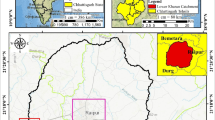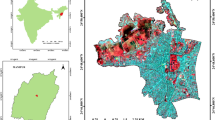Abstract
The aim of this study is to analyze spatio-temporal variability in Land Surface Temperature (LST) in and around the city of Zonguldak as a result of the growing urbanization and industrialization during the last decade. Three Landsat 5 data and one Landsat 8 data acquired on different dates were exploited in acquiring LST maps utilizing mono-window algorithm. The outcomes obtained from this study indicate that there exists a significant temperature rise in the region for the time period between 1986 and 2015. Some cross sections were selected in order to examine the relationship between the land use and LST changes in more detail. The mean LST difference between 1986 and 2015 in ERDEMIR iron and steel plant (6.8 °C), forestland (3 °C), city and town centers (4.2 °C), municipal rubbish tip (−3.9 °C), coal dump site (12.2 °C), and power plants’ region (7 °C) were presented. In addition, the results indicated that the mean LST difference between forestland and city centers was approximately 5 °C, and the difference between forestland and industrial enterprises was almost 8 °C for all years. Spatio-temporal variability in LST in Zonguldak was examined in that study and due to the increase in LST, policy makers and urban planners should consider LST and urban heat island parameters for sustainable development.









Similar content being viewed by others

References
Abbott, P. L. (2012). Natural disasters (8th ed.). Boston: McGraw-Hill.
Amiri, R., Weng, Q., Alimohammadi, A., & Alavipanah, S. K. (2009). Spatial–temporal dynamics of land surface temperature in relation to fractional vegetation cover and land use/cover in the Tabriz urban area, Iran. Remote Sensing of Environment, 113, 2606–2617. doi:10.1016/j.rse.2009.07.02.
Antrop, M. (2004). Landscape change and the urbanization process in Europe. Landscape and Urban Planning, 67, 9–26. doi:10.1016/S0169-2046(03)00026-4.
Balçik, F. B. (2014). Determining the impact of urban components on land surface temperature of Istanbul by using remote sensing indices. Environmental Monitoring and Assessment, 186, 859–872. doi:10.1007/s10661-013-3427-5.
Becker, F., & Li, Z. L. (1990). Temperature-independent spectral indices in TIR bands. Remote Sensing of Environment, 32, 17–33. doi:10.1016/0034-4257(90)90095-4.
Çelik, O., Semerci, A., Şanlı, B., Belindir, B., & ve Gedik, Ö. (2002). Ankara çevresinde anadolu karaçamlarında (pinus nigra Arn. Ssp.Pallasiana lamb. Holmboe) görülen kurumaların nedenleri. Orman Mühendisliği, 39, 7–16.
Demir, A. (2009). Küresel Iklim Değişikliğinin Biyolojik Çeşitlilik ve Ekosistem Kaynakları Üzerine Etkisi: the effects of global climate change on biodiversity and ecosystems resources. Ankara Üniversitesi Çevrebilimleri Dergisi, 2(1), 037–054.
Demirel, H., Sertel, E., Kaya, Ş., & Seker, D. Z. (2008). Exploring impacts of road transportation on environment: a spatial approach. Desalination, 226(1-3), 279–288. doi:10.1016/j.desal.2007.02.111.
Diffenbaugh, N. S., Pal, J. S., Giorgi, F., & Gao, X. (2007). Heat stress intensification in the Mediterranean climate change hotspot. Geophysical Research Letters, 34, L11706. doi:10.1029/2007GL030000.
Environmental Protection Agency (EPA). (2008). Reducing urban heat islands: compendium of strategies-urban heat island basics. Retrieved April 14, 2014, from http://www.epa.gov/heatisland/resources/pdf/BasicsCompendium.pdf.
Gillespie, A. R. (1985). Lithologic mapping of silicate rocks using TIMS. Proceedings TIMS Data User’s Workshop. JPL Publ., vols. 86– 38 (pp. 29– 44). Pasadena, CA: Jet Propulsion Laboratory.
Gillespie, A. R., Rokugawa, S., Matsunaga, T., Cothern, J. S., Hook, S. J., & Kahle, A. B. (1998). A temperature and emissivity separation algorithm for advanced space borne thermal emission and reflection radiometer (ASTER) images. IEEE Transactions on Geoscience and Remote Sensing, 36, 1113–1126. doi:10.1109/36.700995.
Guo, Z., Wang, S. D., Cheng, M. M., & Shu, Y. (2012). Assess the effect of different degrees of urbanization on land surface temperature using remote sensing images. Procedia Environmental Sciences, 13, 935–42. doi:10.1016/j.proenv.2012.01.087.
Guo, G., Wu, Z., Xiao, R., Chen, Y., Liu, X., & Zhang, X. (2015). Impacts of urban biophysical composition on land surface temperature in urban heat island clusters. Landscape and Urban Planning, 135, 1–10. doi:10.1016/j.landurbplan.2014.11.007.
James, M. M., & Mundia, C. N. (2014). Dynamism of land use changes on surface temperature in Kenya: a case study of Nairobi City. International Journal of Science and Research, 3(4), 38–41.
Jiang, J., & Tian, G. (2010). Analysis of the impact of land use/land cover change on land surface temperature with remote sensing. Procedia Environmental Sciences, 2(5), 571–75. doi:10.1016/j.proenv.2010.10.062.
Jiang, Y., Fu, P., & Weng, Q. (2015). Assessing the impacts of urbanization-associated land use/cover change on land surface temperature and surface moisture: a case study in the Midwestern united states. Remote Sensing, 7, 4880–4898. doi:10.3390/rs70404880.
Jimenez-Munoz, J. C., & Sobrino, J. A. (2003). A generalized single-channel method for retrieving land surface temperature from remote sensing data. Journal of Geophysical Research, 108(D22), 4688. doi:10.1029/2003JD003480,2003.
Jüttner, K., Galla, U., & Schmieder, H. (2000). Electrochemical approaches to environmental problems in the process industry. Electrochimica Acta, 45, 2575–2594. doi:10.1016/S0013-4686(00)00339-X.
Kant, Y., Bharath, B. D., Mallick, J., Atzberger, C., & Kerle, N. (2009). Satellite-based analysis of the role of land use/land cover and vegetation density on surface temperature regime of Delhi, India. Journal of the Indian Society of Remote Sensing, 37, 201–14. doi:10.1007/s12524-009-0030-x.
Kaya, Ş. (2007). Multitemporal analysis of rapid urban growth in Istanbul using remotely sensed data. Environmental Engineering Science, 24(2), 228–233. doi:10.1089/ees.2005.0040.
Kaya, S., Basar, U. G., Karaca, M., & Seker, D. Z. (2012). Assessment of urban heat islands using remotely sensed data. Ekoloji, 21(84), 107–113. doi:10.5053/ekoloji.2012.8412.
Kaya, Ş., Pekin, F., Seker, D. Z., & Tanık, A. (2014). An algorithm approach for the analysis of urban land use/cover: logic filters. International Journal of Environment and Geoinformatics, 1(1), 12–20.
Kealy, P. S., & Gabell, A. R. (1990). Estimation of emissivity and temperature using alpha coefficients. Proceedings of Second TIMS Workshop, 90–95, 11–15. JPL Publ.
Landsat Project Science Office. (2002). Landsat 7 science data user’s handbook. Greenbelt: Goddard Space Flight Center.
Landsat Project Science Office. (2015). Landsat 8 science data user’s handbook. Retrieved November 5, 2015, from https://landsat.usgs.gov/documents/Landsat8DataUsersHandbook.pdf.
Landsat Science. (2014). Landsat applications. Retrieved April 10, 2014, from http://landsat.gsfc.nasa.gov/?p=3501.
Li, J., Song, C., Cao, L., Zhu, F., Meng, X., & Wu, J. (2011). Impacts of landscape structure on surface urban heat islands: a case study of Shanghai, China. Remote Sensing of Environment, 115, 3249–3263. doi:10.1016/j.rse.2011.07.008.
Lv, Z., & Zhou, Q. (2011). Utility of landsat image in the study of land cover and land surface temperature change. Procedia Environmental Sciences, 10, 1287–92. doi:10.1016/j.proenv.2011.09.206.
Nguyen, O. V., Kawamura, K., Trong, D. P., Gong, Z., & Suwandana, E. (2015). Temporal change and its spatial variety on land surface temperature and land use changes in the Red River Delta, Vietnam, using MODIS time-series imagery. Environmental Monitoring and Assessment, 187, 464. doi:10.1007/s10661-015-4691-3.
Oke, T. R. (1997). Urban climates and global environmental change. In R. D. Thompson & A. H. Perry (Eds.), Applied climatology: principles and practice (pp. 273–287). New York: Routledge.
Onishi, A., Cao, X., Ito, T., Shi, F., & Imura, H. (2010). Evaluating the potential for urban heat-island mitigation by greening parking lots. Urban Forestry and Urban Greening, 9, 323–332. doi:10.1016/j.ufug.2010.06.002.
Qian, L. X., Cui, H. S., & Jie, C. (2006). Impacts of land use and cover change on land surface temperature in the Zhujiang Delta. Pedosphere, 16(6), 681–689.
Qin, Z., Karnieli, A., & Berliner, P. (2001). A mono-window algorithm for retrieving land surface temperature from Landsat TM data and its application to the Israel-Egypt border region. International Journal of Remote Sensing, 22(18), 3719–3746. doi:10.1080/01431160010006971.
Riebeek, H. (2010). Global warming. NASA-Earth Observatory, http://earthobservatory.nasa.gov/Features/GlobalWarming/.
Seker, D. Z., Kaya, S., Alkan, R. M., Tanik, A., & Saroglu, E. (2008). 3D coastal erosion analysis of Kilyos-Karaburun region using multi-temporal satellite image data. Fresenius Environmental Bulletin, 17(11B), 1977–1982.
Sekertekin, A. (2013). Determining regional environmental effects by remote sensing data: a case study Of Zonguldak. Bulent Ecevit University, Graduate School of Natural and Applied Sciences, Master Thesis. 83p.
Sertel, E., Findik, N., Kaya, Ş., Seker, D. Z., & Samsunlu, A. (2008). Assessment of landscape changes in the Kizilirmak Delta, Turkey using remotely sensed data and GIS. Environmental Engineering Science, 25(3), 353–362. doi:10.1089/ees.2006.0149.
Sharma, R., Chakraborty, A., & Joshi, P. K. (2015). Geospatial quantification and analysis of environmental changes in urbanizing city of Kolkata (India). Environmental Monitoring and Assessment, 187, 4206. doi:10.1007/s10661-014-4206-7.
Shen, G., Ibrahim, A. N., Wang, Z., Ma, C., & Gong, J. (2015). Spatial-temporal land-use/land-cover dynamics and their impacts on surface temperature in Chongming Island of Shanghai, China. International Journal of Remote Sensing, 36(15), 4037–4053. doi:10.1080/01431161.2015.1043404.
Snyder, W. C., Wan, Z., Zhang, Y., & Feng, Y. Z. (1998). Classification based emissivity for land surface temperature measurement from space. International Journal of Remote Sensing, 19, 2753–2774. doi:10.1080/014311698214497.
Sobrino, J. A., & Raissouni, N. (2000). Toward remote sensing methods for land cover dynamic monitoring: application to Morocco. International Journal of Remote Sensing, 21(2), 353–366. doi:10.1080/014311600210876.
Sobrino, J. A., Li, Z. L., Stoll, M. P., & Becker, F. (1996). Multi-channel and multi-angle algorithms for estimating sea and land surface temperature with ATSR data. International Journal of Remote Sensing, 17, 2089–2114. doi:10.1080/01431169608948760.
Sobrinoa, J. A., Jimenez-Munoz, J. C., & Paolini, L. (2004). Land surface temperature retrieval from LANDSAT TM 5. Remote Sensing of Environment, 90, 434–440. doi:10.1016/j.rse.2004.02.003.
U.S. Geological Survey. (2014). Technical announcement: USGS completes decommissioning of Landsat 5. Retrieved April 12, 2014, from http://www.usgs.gov/newsroom/article.asp?ID=3626#.U1gRFGCKDIV.
Valor, E., & Caselles, V. (1996). Mapping land surface emissivity from NDVI: application to European. African and South American areas. Remote Sensing of Environment, 57, 167–184. doi:10.1016/0034-4257(96)00039-9.
van de Griend, A. A., & Owe, M. (1993). On the relationship between thermal emissivity and the normalized difference vegetation index for natural surfaces. International Journal of Remote Sensing, 14, 1119–1131. doi:10.1080/01431169308904400.
Voogt, J. A., & Oke, T. R. (2003). Thermal remote sensing of urban climates. Remote Sensing of Environment, 86, 370–384. doi:10.1016/S0034-4257(03)00079-8.
Watson, K. (1992). Spectral ratio method for measuring emissivity. Remote Sensing of Environment, 42, 113–116. doi:10.1016/0034-4257(92)90094-Z.
Weng, Q., Lu, D., & Schubring, J. (2004). Estimation of land surface temperature-vegetation abundance relationship for urban heat island studies. Remote Sensing of Environment, 89, 467–483. doi:10.1016/j.rse.2003.11.005.
Xiao, H., & Weng, Q. (2007). The impact of land use and land cover changes on land surface temperature in a karst area of China. Journal of Environmental Management, 85, 245–257. doi:10.1016/j.jenvman.2006.07.016.
Author information
Authors and Affiliations
Corresponding author
Rights and permissions
About this article
Cite this article
Sekertekin, A., Kutoglu, S.H. & Kaya, S. Evaluation of spatio-temporal variability in Land Surface Temperature: A case study of Zonguldak, Turkey. Environ Monit Assess 188, 30 (2016). https://doi.org/10.1007/s10661-015-5032-2
Received:
Accepted:
Published:
DOI: https://doi.org/10.1007/s10661-015-5032-2



